Durabook Americas Durabook R8300
Ultra-rugged, no-compromise notebook computer for the toughest jobs out there
(by Conrad H. Blickenstorfer April 2018 — also see summary review of the Durabook R8300)
Share on:




Late 2017, Durabook Americas announced a substantial technology and performance update to their Durabook R8300. The R8300 — the first fully rugged notebook computer sold under the Durabook brand and now in its third generation — is designed and manufactured specifically to operate and survive in extremely harsh environments such as, among others, those routinely encountered by the military, in public safety deployments, and by the utility sector. The R8300 platform now offers Intel 7th generation Core processors, improved graphics capabilities, increased battery life and the comprehensive security offered by Windows 10.
Durabook In this article we're taking a comprehensive look at the R8300 platform, one of the very few truly rugged notebook computers available today.
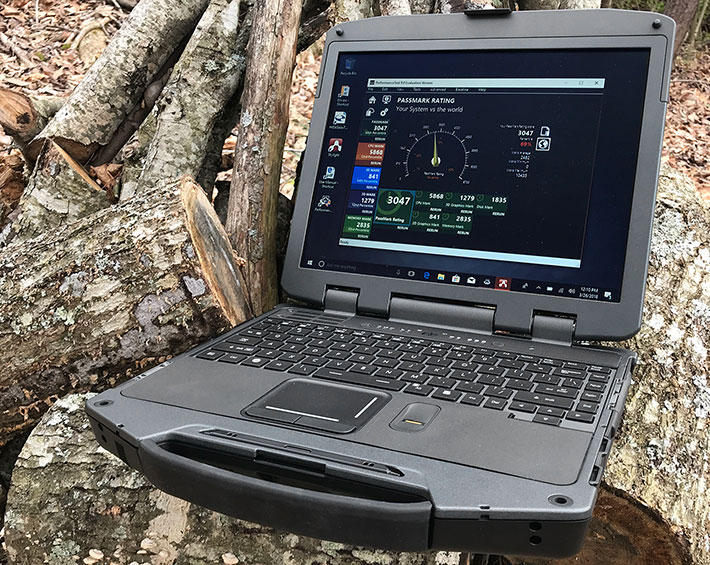
Right upfront, please note that unlike tablets — which eight years after the introduction of the original iPad still continue searching for the best design, implementation and use in vertical and industrial markets — ruggedized notebooks such as the Durabook R8300 represent a very mature class of machines, one that goes back a quarter of a century when pioneering computer makers began beefing up standard notebook computers to make them more suitable for work in the field. Back then, adequate battery life, acceptable performance, and outdoor usable displays were almost insurmountable obstacles.
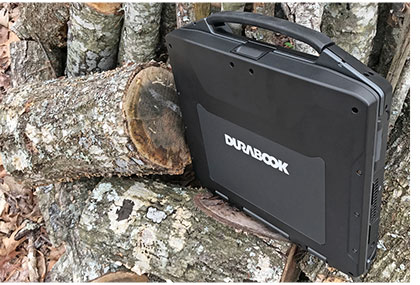 Those issues have long since been resolved. Between new display technology, Intel's fast Core processors, and the maturity of ruggedization technology, hardened notebooks such as the Durabook R8300 allow computing anytime and anywhere. And their total cost of ownership is almost always considerably lower than that of consumer technology.
Those issues have long since been resolved. Between new display technology, Intel's fast Core processors, and the maturity of ruggedization technology, hardened notebooks such as the Durabook R8300 allow computing anytime and anywhere. And their total cost of ownership is almost always considerably lower than that of consumer technology.
In terms of design and execution, the Durabook R8300 is first class. A magnesium alloy case and internal frame and structure make for an exceedingly solid machine, and also a complex one with numerous carefully conceived and executed details. For all its toughness, though, the R8300 is fairly compact, measuring just 12.0 x 11.6 x 2.4 inches, including an integrated carry handle, and weighing around eight pounds.
In addition to all its toughness, the R8300 convinces with a sturdy, spring-loaded carry handle and excellent and utmost reliable wireless performance via integrated antenna systems for fast and accurate fixes, advanced RF shielding and noise filtering, and good onboard connectivity and expansion potential via externally accessible card slots and a flexible-use media bay. Customers of the older General Dynamics Itronix XR-1 and GD8000/8200 computers appreciate the Durabook R8300's compatibility with all existing docks and peripherals, in addition, of course, to a significant performance and technology boost. And new customers will find in the Durabook R8300 a strong competitor to the ultra-ruggeds from Getac and Panasonic.
Design and details
As far as design, engineering, materials and execution is concerned, the Durabook R8300 is absolutely first class. Both the external case and the internal frame and structure are magnesium alloy, which makes for an impressively solid machine. Despite the compact, form-follows-function design, this is also a complex design that shows a lot of thought and careful execution. While many rugged tablets and notebooks simply consist of an upper and lower half with a seal between, the R8300's design is far more spatially intricate. It's not obvious from the outside, for example, that the R8300's system unit with the keyboard consists of a sealed inner chamber that contains all the sensitive electronics, and then perimeter compartments for ports, heat exchangers, antennae, etc., that are technically outside the computer. This is why some of the R8300's port covers are designed for physical protection, and not as watertight seals.
The R8300 sports the kind of timelessly rugged good looks found in industrial gear designed for a purpose. The dark gray/light gray color scheme is quite attractive and exudes an understated elegance. There are no protruding rubber bumpers, and while they're always a quick way to boost drop specs, the R8300 doesn't seem to need them to achieve its desired ruggedness goals (it would seem to be simple enough, though, to design and offer them as options).
As far as overall footprint goes, the R8300 is squareish and — compared to modern consumer notebooks with their wide-format screens — looks tall and narrow when you flip open the LCD case. That's because of the machine's heritage that mandated staying with the same footprint for several generations so as not to render mounting hardware, docks, peripherals and even software obsolete. Fact is that for a good many years, rugged notebooks had 13.3-inch displays with a 4:3 aspect ratio and using 1024 x 768 pixel XGA resolution. That's what the R8300's primary competition — the Getac B300 — still uses, and so does this latest R8300.
As is, below you can see the top and all for sides of the Durabook R8300:
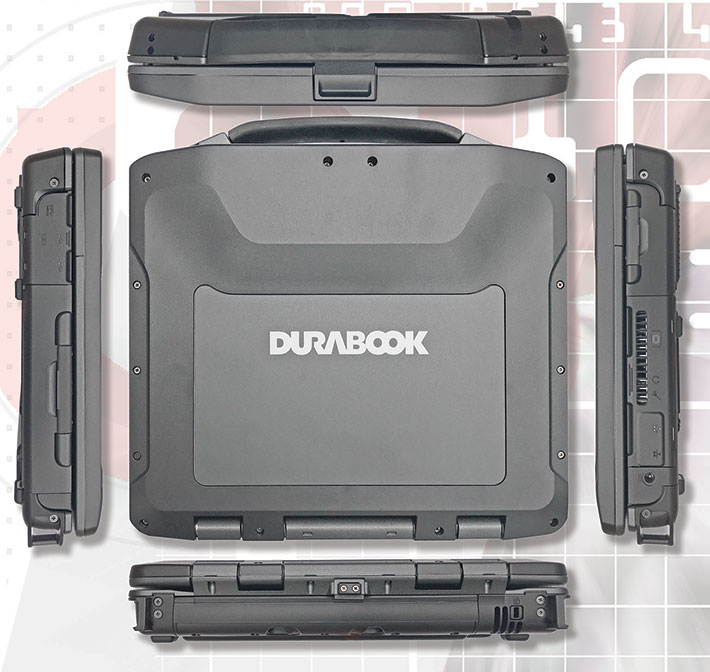
The next two pictures show the right side (top) and the left side (bottom) of the R8300 with all protective covers open.
The right side has two USB 2.0 ports, one USB 3.0 port, a standard DB9 serial port, a multi-purpose media bay that can accommodate one of a variety of optical drives or a second battery and, below it, a Type II PC Card slot. The USB 3.0 port, which uses blue instead of black plastic, can transmit data at up 5Gbit/s, more than ten times faster than USB 2.0. Note that the PC Card slot is optional; customers can get an (also optional) FIPS 201 SmartCard reader or an ExpressCard/54 card reader instead.

On the left side are, from left to right, the power jack, two RJ45 gigabit LAN jacks, microphone and audio-out jacks, a VGA port (an HDMI port is optional), and a Smart Card Reader with an SD card slot below it. Here you can also see the unit's cooling fan exhaust (the fan rarely ever came on during our tests).

The R8300's 88-key keyboard with individual keys is full-scale. It has black keys with very legible white labels. Special keyboard functions (such as brightness, volume, screen blackout, etc.) are indicated in small white symbols. There is no separate keypad, but keypad functionality is available and marked with small white numbers. The R8300 keyboard is backlit with four levels of brightness that can be set via the keyboard.
Below the keyboard are a properly sized and slightly recessed (so you can feel its boundaries in the dark) capacitive touchpad and two mouse buttons. Rugged notebooks often have resistive touchpads because those work in the rain and with gloves on. On the negative side, they can be hard to manipulate, and so Durabook Americas decided to go with the far more versatile capacitive touchpad that actually has multi-touch capabilities. You can use multi-touch to zoom, rotate, pan in whatever software supports that functionality, and it's also easy to scroll and even use gestures on it.
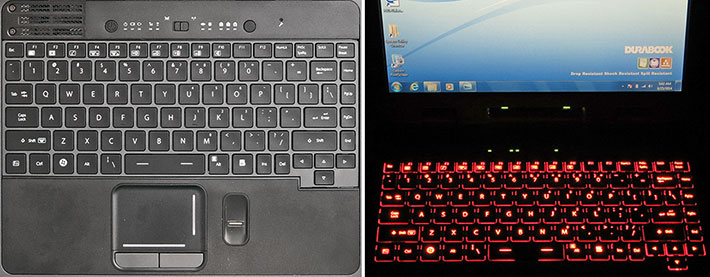
The picture above shows (left) the keyboard layout of the R8300 with its trackpad, fingerprint scanner, wireless on/off button, programmable application launch key, and (right) the R8300 in complete darkness with the keyboard backlight on.
Under the Hood
The bottom side of the R8300 provides quick and easy access to user-replaceable modules and components. The picture below shows the bottom side of the machine on the left, and the same view with its three backside covers removed.
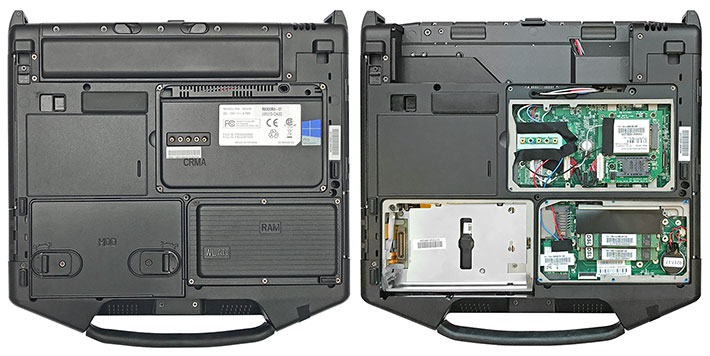
The WLAN/RAM compartment, which is clearly marked with "RAM" and "WLAN," has a plastic cover, held in place by six small Philips screws, with a water-tight pressure seal. Inside, there are the system's two SO-DIMM slots for our R8300's two 8GB PC4-2133 memory modules. The compartment also has a mini-PCIe slot that's taken up by an Intel 8260NGW half-card (bottom right in the picture, next to the RAM).
The cover to the CRMA ("Common Radio Module Architecture") wireless compartment (middle right in the above picture) may cause a bit of alarm as it appears to have air vents and seemingly unsealed connectors for external WWAN and WLAN antennas. Looks deceive, though, as the metal CRMA cover actually has a pressure seal around the CRMA bay cutout, and another pressure seal around the antenna ports, so the vented part is technically outside of the sealed interior of the computer. Pressure seals are a bit vulnerable, but as long as they are well maintained they do the job. The designers came up with an elegant solution here.
A third door (bottom left) covers the hard disk compartment. In order to open it you need to twist two rotating latch mechanisms. 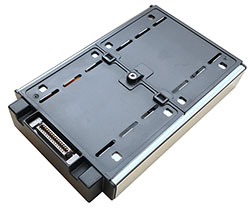 Each latch is additionally held in place with a Philips screw that must be removed before the latch can be rotated.
Each latch is additionally held in place with a Philips screw that must be removed before the latch can be rotated.
Why not just use screws? Because in certain situations it may be necessary to quickly remove the hard disk without first locating a screw driver and messing with tiny screws. If that is the case, then the little screws are not used. If it's not necessary, put the screws in for additional security.
The disk itself is mounted inside the caddy in a separate suspension systems that uses vibration and impact resistant material made of a high-performance thermoplastic that maintains its vibration isolating and dampening properties in all temperatures.
The whole assembly is about as intricate, well-thought-out, and meticulously designed and engineered a protective disk enclosure as we've seen, and it's considerably more advanced a solution than most we've seen. The disk itself in our unit was an Innodisk 2.5-inch Industrial 3ME4 Series SATA solid state drive that hardly needed such an elaborate caddy, but it's definitely a good thing to have for units equipped with rotating media.
Integrated Wireless
Durabook Americas and its OEM customers were early supporters and providers of state-of-the-art integrated wireless with optimal performance and signal reception, and this heritage still shows.
The R8300 can support up to four integrated radios: WLAN, WWAN, GPS and WPAN.
The WiFi module in our tester was an Intel Centrino Advanced-N 6235 Mini Card (see spec sheet), a dual-band 802.11a/g/n wireless network adapter that operates in both the 2.4 GHz and 5.0 GHz spectra. The adapter delivers up to 300 Mbps of bandwidth with dual streams for maximum performance even in difficult places. This being an Intel product, it supports Intel WiFi Direct (connect w/o hot spot or access point), Intel Smart Connect Technology (update while asleep), Intel Wireless Display, and Intel My WiFi Dashboard (app to manage connectivity). Advanced-N 6235 also includes dual-mode Bluetooth that supports versions 2.1, 2.1 + EDR, 3.0, 3.0 + HS, as well as 4.0.
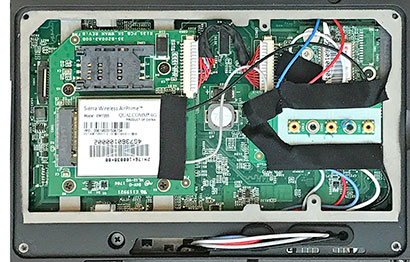 Now what is the "CRMA" stenciled into the compartment cover all about? CRMA, the Common Radio Module Architecture, was conceived since radio technologies and standards changed so quickly that the life expectancy of any integrated radio module was less than half that of the computer itself. CRMA modules were designed to be immune to vibration and drops, and could be replaced if a carrier launched a new radio service. The modules were also more robust and reliable than the card-based radios of the time.
Now what is the "CRMA" stenciled into the compartment cover all about? CRMA, the Common Radio Module Architecture, was conceived since radio technologies and standards changed so quickly that the life expectancy of any integrated radio module was less than half that of the computer itself. CRMA modules were designed to be immune to vibration and drops, and could be replaced if a carrier launched a new radio service. The modules were also more robust and reliable than the card-based radios of the time.
While the manual refers to various CRMA options, it is not clear whether Durabook Americas continues the exact CRMA approach used in GD-Itronix-labeled predecessors of the R8300 as technology has moved on and wireless components have become smaller, more integrated and more reliable. As is the CRMA compartment in our review R8300 contained a Sierra Wireless AirPrime EM7355 embedded wireless module that supports 3G quad-band GSM/GPRS/EDGE networks, the HSPA+ (High-Speed Packet Access Plus)/UMTS (Universal Mobile Telecommunications Systems) protocols, 4G LTE, as well as CDMA 1xRTT/EV-DO Rev A. The Sierra Wireless PCIe module is mounted on its own board that also contains a SIM card slot, and is therefore easily replaceable.
Signal reception is a huge issue for computers that are used in the field and on the road where they are often operating at the fringe of radio signal coverage. This makes superior antenna performance mandatory. The R8300 uses several internal antennas, located in various parts of the machine, for greater range, superior coverage area, and optimal reception.
And since the Durabook R8300 may be used in military and other applications that require complete radio silence, all radios can be turned off instantly via a hardware slider switch located right above the keyboard.
Performance
Unlike with desktop computers that you simply plug into the wall, mobile systems require a careful balance between performance and battery life. That's why Intel differentiates between desktop and mobile processors, and why power conservation technology is very high on Intel's list of priorities. 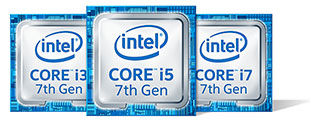 Optimizing this performance vs. battery life issue is an art, one that manufacturers often handle by offering customers the choice of several processors so they can pick the one that suits their application and priorities.
Optimizing this performance vs. battery life issue is an art, one that manufacturers often handle by offering customers the choice of several processors so they can pick the one that suits their application and priorities.
The latest generation of the R8300 benefits from the availability of state-of-the-art Intel 7th generation "Kaby Lake" Core processors. Customers now have the choice of three different of those new processors. Two CPUs from the last generation of the R8300 carry over, the 6th generation "Skylake" Core i7-6500U and i5-6200U. Why? Because Kaby Lake doesn't support the Windows 7 downgrade option anymore whereas Skylake still does. Here's what customers can choose from:
|
Durabook R8300 R3 processor options
|
|
Available R8300 R3 CPUs
|
Intel Core i7
|
Intel Core i7
|
Intel Core i5
|
Intel Core i7
|
Intel Core i5
|
|
Model
|
7600U
|
7500U
|
7200U
|
6500U
|
6200U
|
|
Cores/Threads
|
2/4
|
2/4
|
2/4
|
2/4
|
2/4
|
|
Base Clock Speed
|
2.80 GHz
|
2.70 GHz
|
2.50 GHz
|
2.50 GHz
|
2.30 GHz
|
|
Turbo Speed
|
3.90 GHz
|
3.50 GHz
|
3.10 GHz
|
3.10 GHz
|
2.80 GHz
|
|
Thermal Design Power (TDP)
|
15 watts
|
15 watts
|
15 watts
|
15 watts
|
15 watts
|
|
Smart Cache
|
4MB
|
4MB
|
3MB
|
4MB
|
3MB
|
|
Integrated graphics
|
HD Graphics 620
|
HD Graphics 620
|
HD Graphics 620
|
HD Graphics 520
|
HD Graphics 520
|
|
Graphics base speed
|
300 MHz
|
300 MHz
|
300 MHz
|
300 MHz
|
300 MHz
|
|
Graphics max speed
|
1.15 GHz
|
1.05 GHz
|
1.00 GHz
|
1.05 GHz
|
1.00 GHz
|
|
Intel Stable Image Platform Program
|
Yes
|
No
|
No
|
No
|
No
|
|
Intel TSX-NI
|
Yes
|
No
|
No
|
No
|
No
|
|
Intel Trusted Execution
|
Yes
|
No
|
No
|
No
|
No
|
|
Intel vPro
|
Yes
|
No
|
No
|
No
|
No
|
|
Win 7 downgrade
|
No
|
No
|
No
|
Yes
|
Yes
|
The difference between the chips is relatively subtle, but can be important if the availability of certain integrated processor options matters. Here's a brief explanation of Intel technologies that the top-of-the-line i7-7600U has, but the other processor options do not:
- vPro provides extra security and management capabilities that are required in many enterprise deployments (see Wiki Intel vPro).
- TSX-NI Transactional Synchronization Extensions New Instructions) helps make parallel operations more efficient via improved control of locks in software (see Wiki TSX).
- SIPP (Stable Image Platform Program) allows deployment of standardized, stable image PC platforms for at least 15 months (see Intel SIPP), and
- Trusted Execution technology provides security capabilities such as measured launch and protected execution, and may thus also be an enterprise requirement (see Wiki Trusted Execution Technology).
To find out what all this new performance technology amounts to, we used Passmark Software's PerformanceTest that runs about 30 tests covering CPU, 2D graphics, 3D graphics, memory, and disk and then computes scores for each category and an overall PassMark score. We also ran our secondary benchmark suite, CrystalMark, which breaks performance down into several additional categories. For comparison, we included the benchmarks of an earlier R8300 we tested, as well as the General Dynamics Itronix GD8200 branded version of the R8300, and the most recent data we have on competitor machines. Below is what we found:
|
Durabook Americas Durabook R8300 Benchmarks and Comparisons
|
|
PERFORMANCE COMPARISON
|
Durabook
|
Durabook
|
GD-Itronix
|
Dell
|
Getac
|
Panasonic
|
|
Model
|
R8300
|
R8300
|
GD8200
|
14 Extreme
|
B300
|
CF-33
|
|
Year tested
|
2018
|
2014
|
2011
|
2015
|
2017
|
2018
|
|
Passmark version
|
9.0
|
6.1
|
6.1
|
6.1
|
6.1
|
9.0
|
|
Processor Type: Intel
|
Core i7
|
Core i7
|
Core i7
|
Core i5
|
Core i7
|
Core i5
|
|
Processor Model
|
7500U
|
3667U
|
2655LE
|
4300U
|
6500U
|
7300U
|
|
Processor Code
|
Kaby Lake (7th)
|
Ivy Bridge (3rd)
|
Sandy Bridge (2nd)
|
Haswell (4th)
|
Skylake (6th)
|
Kaby Lake (7th)
|
|
CPU Speed
|
2.70GHz
|
2.00GHz
|
2.20GHz
|
1.90GHz
|
2.50GHz
|
2.60GHz
|
|
Turbo Speed
|
3.50GHz
|
3.20GHz
|
2.90GHz
|
2.90GHz
|
3.10GHz
|
3.50GHz
|
|
Thermal Design Power (TDP)
|
15 watts
|
17 watts
|
25 watts
|
15 watts
|
15 watts
|
15 watts
|
|
CPU Mark
|
5,882.2
|
3,685.6
|
2,145.9
|
3,522.0
|
4,577.3
|
5,424.2
|
|
2D Graphics Mark
|
845.6
|
546.5
|
325.4
|
474.7
|
490.2
|
600.1
|
|
Memory Mark
|
2,828.1
|
1,822.8
|
721.8
|
1,144.1
|
1,335.3
|
2,277.6
|
|
Disk Mark
|
1,994.6
|
1,294.2
|
659.7
|
3,984.7
|
2,916.0
|
3,142.9
|
|
3D Graphics Mark
|
1,277.0
|
438.3
|
280.7
|
484.3
|
564.6
|
473.2
|
|
Overall PassMark
|
3,100.5
|
1,711.2
|
920.5
|
2,078.4
|
2,195.86
|
2,205.9
|
|
ALU
|
55,168
|
43,695
|
36,356
|
42,120
|
48,741
|
55,775
|
|
FPU
|
55,644
|
47,207
|
37,233
|
39,941
|
51,552
|
56,367
|
|
MEM
|
60,923
|
47,328
|
39,157
|
43,971
|
58,244
|
60,679
|
|
HDD
|
30,969
|
25,369
|
12,520
|
42,880
|
33,772
|
37,624
|
|
GDI
|
20,170
|
17,192
|
11,740
|
16,050
|
17,007
|
18,321
|
|
D2D
|
7,295
|
2,432
|
1,518
|
14,219
|
6,194
|
6,350
|
|
OGL
|
14,637
|
6,508
|
2,438
|
32,989
|
15,246
|
13,630
|
|
Overall CrystalMark
|
244,806
|
190,001
|
140,962
|
232,170
|
230,756
|
248,746
|
The results are not as comprehensive as we'd like them to be, primarily because we don't have current benchmark figures for some of the R8300's most direct competitors. The Dell Latitude 14 Extreme Rugged, for example, now comes with Intel 6th generation Skylake processors.
Also note that compared to just a few years ago, there now is largely performance parity between the leading rugged laptop brands. Why? Because back then, rugged laptop designers had to decide between performance and battery life. It was not possible to have both. So some specialized on high-performance whereas others favored long battery life. Today, with Intel's high-end Core processors so energy-efficient, you can have both, performance and long battery life.
Most vendors, however, offer a larger choice of processor options than in the past. Durabook Americas offers no fewer than five. This, in conjunction with many other configuration options, lets customers pick the features they want and need (and fit into their budgets).
What is interesting is the massive technology advance since the conception of the R8300 platform. The new R8300 we tested is at least three times as powerful than the final GD-Itronix version (the GD8200), so anyone still running those old machines would benefit greatly from an upgrade. Even compared to the earliest Durabook-branded R8300 we tested, the new machine offers a massive performance increase.
A couple of more general comments with regard to the performance in this class of ultra-rugged laptops: while basic processor performance has improved with every generation of Intel's Core processors, much larger gains were realized in graphics performance and power efficiency. Earlier Core processors didn't have much graphics punch and greatly benefitted from third-party "discrete" graphics sub-systems. Late generation Core processors have much better graphics, making discrete graphics unnecessary for most applications. Power conservation also has come a very long way. As you'll see in the next section, minimum power draws are now a fraction of what they used to be.
Another performance aspect that we cannot emphasize enough: those who need every last possible ounce of performance should consider available solid state disk options. SSDs speed up overall operation very considerably. If top performance matters, they are well worth the extra cost.
Power and Battery Life
In terms of battery life, Durabook Americas claims 14 hours of running time on a charge. And if that is not enough, the R8300's media bay can accommodate a second (smaller 41.1 watt-hour) battery that Durabook Americas claims boosts combined battery life to 20.5 hours, and in addition also provides battery hot-swapping.
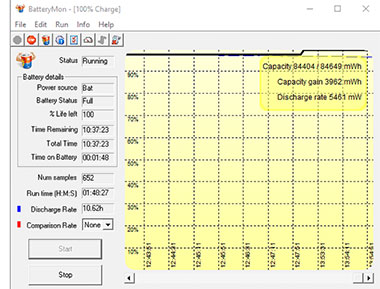 The main battery is a powerful 11.1 Volt, 7,800 mAH Li-Ion pack. That makes for 86 watt-hours. We ran our standard BatteryMon drawdown benchmarks to determine power draw and projected battery life.
The main battery is a powerful 11.1 Volt, 7,800 mAH Li-Ion pack. That makes for 86 watt-hours. We ran our standard BatteryMon drawdown benchmarks to determine power draw and projected battery life.
In Windows "Power Saver" mode, with radios off and backlight at the lowest level (which is really off entirely and only visible in sunlight), we saw a minimum of 4.5 watts. With the backlight at default level, it was 6.4 watts, and with all radios on and the backlight at full-bright about 8.6 watts. Dividing the available 86 watt-hours of a fully charged battery by the lowest observed battery draw of 4.5 watts would indicate a theoretical battery life of 19.1 hours.
In Windows "Balanced" mode, with backlight at its lowest level and radios off we saw 4.9 watts. With the backlight at default level, it was 7.3 watts, and with all radios on and the backlight at full-bright about 10.5 watts. So even in balanced power mode and backlight at medium, 12 hours are possible, but with screen brightness cranked all the way up there's still over eight hours.
|
Durabook R8300 Power Draws (at idle)
|
|
Backlight level
|
Lowest (0%)
|
50%
|
Maximum (100%)
|
|
Power Saver
|
4.5 watts
|
6.4 watts
|
8.6 watts
|
|
Balanced
|
4.9 watts
|
7.3 watts
|
10.5 watts
|
|
Max Performance
|
5.1 watts
|
8.1 watts
|
11.0 watts
|
In Windows "High Performance" mode, backlight at the lowest level but radios on, draw was 5.1 watts. With the backlight at default level, it was 8.1 watts, and with all radios on and the backlight at full-bright about 11.0 watts. This means even in high performance mode and backlight at 50%, it's possible to see 12 hours. And almost 8 hours with the backlight all the way up.
Some outdoor-usable notebooks try to remain visible in sunlight with extremely strong backlights, which can quickly drain the battery. The R8300 backlight is in the 1050 nits range. That's very bright (your average consumer notebook is around 200 nits and iPads in the 450 nits range), but not so bright as to result in unacceptably high battery drawdown.
Real world battery life, of course, varies with the type of amount of work performed, how quickly the machine is set to go into standby, and so on. It also makes a difference whether the fan is running or not. During our battery drawdown testing, the fan was off.
Note that the R8300 also has a battery calibration utility that allows accurate reading of the remaining battery capacity. This is done via a special BIOS level battery calibration procedure in the BIOS setup utility.
Outdoor viewable display
Rugged notebooks like the R8300 will be used outdoors and often in bright sunlight. Most of the standard transmissive LCD displays used in consumer notebooks, however, wash out in daylight, and that's why over the past few years, sunlight-readability has become a major selling point in the rugged notebook sector. After earlier experimentation with a variety of unsatisfactory solutions to the problem, a new era of outdoor-viewable displays began a few years ago with technologies that cleverly combined a strong backlight with optical properties that reduced the reflection of ambient light, therefore retaining enough screen contrast to keep standard transmissive display viewable outdoors.
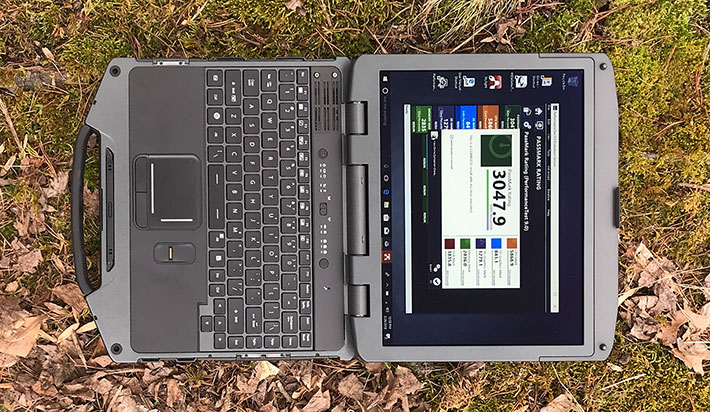
T are really only two practical methods of making a notebook screen readable outdoors. One is to crank up the brightness (measured in nits, which is display-industry slang for "candela per meter squared", or cd/m2) to the point where the light emitted by the screen is sufficiently greater than the ambient light reflected by the screen. The other is to treat the surface of the screen so it reflects much less light, which again allows the emitted light to exceed the reflected light. Almost all currently available rugged notebooks use a combination of those two measures, the R8300 included.
During our testing we spent a considerable amount of time using the R8300 outdoors. The pictures below show what you can realistically expect. The R8300 display is at its best when viewed head-on. The head-on picture below was taken on a bright April afternoon. The image is vibrant and eminently viewable. The blueish tint you see art the right bottom of the screen is what you get when there are reflections on the screen. For a full-size version of the below image compilation, click on it.
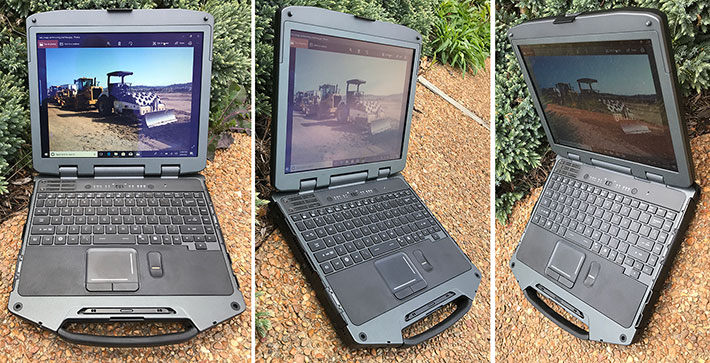
The center and right pictures above shows the display from an angle, and here the situation isn't quite as optimal. Unlike IPS (In Place Switching) screens which have perfect viewing angles from all directions, the TN (Twisted Nematic) LCD used in the R8300 looks best when viewed head-on. TN screens are very quick, but have narrow viewing angles. Viewed from the side or above/below, there are contrast and color changes.
We're not totally pleased with the LCD display's viewing angle. We've become so used to the almost 180-degree viewing angle both vertically and horizontally in most tablets that we no longer expect anything less. The R8300 has a wide horizontal viewing angle but there are some color shifts when looked at from the right. The vertical angle is narrower and there are also still color and contrast shifts.
Overall, the R8300's display is quite impressive, especially considering that it incorporates a touch screen, something which usually cuts brightness and readability (and also introduces some of the reflections we mentioned).
Ruggedness and Protection
As far as ruggedness goes, there's an arms race going on out there as more competitors are entering the potentially lucrative, albeit difficult to crack, rugged mobile computing field. Over the past several years there has been a trend towards not only increased ruggedness, but also toward more in-house and independent third party testing to document ruggedness. How does the Durabook R8300 measure up?
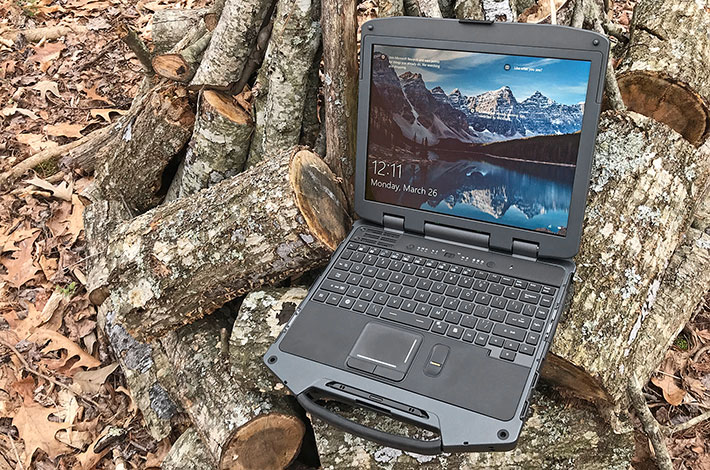
Very well. As the North American subsidiary of Twinhead International Corporation, Durabook Americas has many years of experience in manufacturing large numbers of semi- and fully rugged notebook computers. They know that customer priorities for rugged machines are abundantly clear: "keep it in the field!" Computers deployed in the field must not fail, disrupt operations, and cause costly downtime. Durabook Americas analyzed return and service data, and their conclusion as to what matters most was:
- Real world impact resistance — Computers do drop. The DOD estimates a piece of equipment will be dropped from heights up to four feet an average of four to six times during its life cycle. Most rugged vendors use the drop test procedures described in MIL-STD-810G that mandate 26 drops (one on each edge, surface and corner). But that is with the computer turned off, and the test actually allows using five units to make it through the entire test. This hardly shows how well a single unit will do. On top, many units are dropped while in use, and not while they are off.
To make the test more realistic, Durabook Americas performed the drop test with the computer on and with rotating media instead of solid state memory, as that remains a popular configuration, and to do it with a single machine as a user in the field won't have five machines to pick from. The computer passed the test, with power on, from a drop height of 48 inches, and with a single machine, thus exceeding the MIL-SPEC requirement.
- Real world sealing — The degree of protection against dust and water is usually given in an IP (ingress protection) rating. Again, Durabook Americas felt the commonly used testing methods didn't make much sense. Most units fail as a result of being "rinsed off", i.e. subjected to a LOT of water, or as a result of being rained on, which means less water but potentially over a long period of time.
To make this test more meaningful, in addition to the ANSI/IEC Ingress Protection test, they subjected the unit to the test procedure described in MIL-STD-810G 506.5 Procedure II, which mandates a full four hours of exposure to dripping water, and not just the 15 minutes in the often-used Procedure III. Many rugged machines claim IP54 ingress protection, but Durabook Americas felt that since the 5" still allowed limited dust penetration, they redesigned the sealing to achieve full IP65 protection, where the "5" means protection against low pressure water jets from all directions. According to Durabook Americas, the R8300 also passed an operating test to simulate extreme rain and wind with 5.8" rain per hour blown at 70mph for three hours.
Exposure to salt fog can be an important issue to marine and other customers. Here, Durabook Americas subjected the laptop to the MIL-STD-810G 509.5 procedures with 48 hour exposure to a 5% salt fog followed by a 48 hour drying period.
The R8300, of course, was also tested for vibration, extreme temperatures, altitude, humidity, and so on. The R8300 press materials also include a reference to qualification under the strict MIL-STD 461 Army Ground and Air Force standard. As always, for specific ruggedness testing results, refer to the manufacturer.
Security
Like almost all modern computers, the Durabook R8300 offers several physical and software security measures. There is a swipe style solid-state fingerprint reader located to the right of the touchpad. Biometric fingerprint scanning is very effective and can be used to complement, reduce or eliminate multiple passwords.
The Security Menu in the BIOS lets you set and change both supervisor and user passwords.
The BIOS also lets you enable or disable the R8300's TPM (Trusted Platform Module) support. The TPM 2.0 micro controller with cryptographic functionality allows the creation and management of computer-generated digital certificates. Combined with software, these can be used to:
- Send and received secure email,
- Set up the browser for client identification,
- Sign Word macros,
- Encrypt individual files or entire folders, and
- Create secure network connections.
The R8300's BIOS also offers an unusually extensive set of customization options on top of what you usually get in the BIOS setup. Stealth mode, for example, lets you boot with the LED lights, fan, audio, system beeps, and radios individually turned on or off, and with the backlight initially off. You can also individually disable hardware that could be used to transfer data, such as PC Cards, the optical drive, LAN, wireless radios, and com/USB ports. There is also Computrace support (see here), which allows remote management for ongoing tracking and securing all endpoints within a single cloud-based console.
With all this security, don't forget to get a simple Kensington locking cable for use with the Kensington lock slot on the R8300.
Summary: Durabook R8300
The Durabook R8300 is a very mature platform that has already gone through years and several generations of extensive field use and testing across the globe. Earlier variants of this machine were sold by General Dynamics Itronix as the GD8000 and GD8200, which will certainly make it interesting to customers who seek to replace aging Itronix and General Dynamics Itronix machines. Updated with Intel 7th generation Kaby Lake Bridge technology, the rock-solid Durabook R8300 has the pedigree, performance and versatility to be a valuable work horse in any number of deployments that rely on tough, rugged computers that will not break or fail.
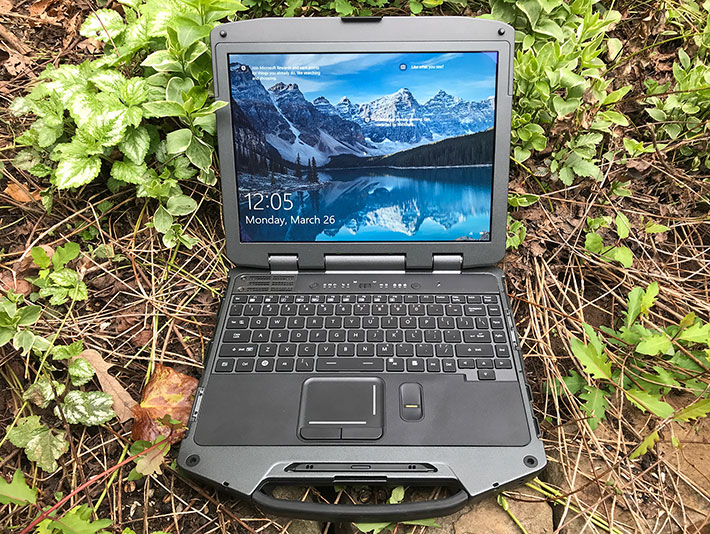
The 13.3-inch 4:3 aspect ratio LCD with 1024 x 768 pixel XGA resolution looks tall and boxy in this era of wide-screen displays, but it offers very good outdoor viewability with a deep, rich image on its display in almost any lighting condition, one that doesn't completely wash out even in direct sunlight.
Wireless performance is strong due to an integrated antenna system for fast and accurate fixes, and the computer's flexible wireless modules compartment. There is good onboard connectivity as well as expansion potential via externally accessible card slots (PC Card and Express Card or Smart Card) and a media bay that can accommodate an optical drive or a second battery.
Users of older GD-Itronix laptops will appreciate the Durabook R8300's full compatibility with all prior XR-1 and GD8000/8200 docks, peripherals and software, and the excellent performance and various technology upgrades and improvements of the Durabook R8300 are strong upgrade and expansion incentives. Both new and existing customers will find in the Durabook Americas Durabook R8300 an expertly designed, engineered and manufactured machine that provides strong performance and good battery life for use in even the most environmentally demanding environments.
– Conrad H. Blickenstorfer, April 2018
Durabook Americas Durabook R8300 Specs
| Added/changed |
Added 11/2017, full review 04/2018
|
| Type |
Fully-rugged notebook
|
| Processor |
With Windows 10:
Core i7-7600U (7th gen Kaby Lake), 4MB cache
Core i7-7500U (7th gen Kaby Lake), 4MB cache
Core i5-7200U (7th gen Kaby Lake), 3MB cache
Win 10 with Win 7 downgrade:
Core i7-6500U (6th gen Skylake), 4MB cache
Core i5-6200U (6th gen Skylake), 3MB cache |
| Processor speed |
With Windows 10:
i7-7600U: 2.80/3.90GHz
i7-7500U: 2.70/3.50GHz
i5-7200U: 2.50/3.10GHze
Win 10 with Win 7 downgrade:
i7-6500U: 2.50/3.10GHz
i5-6200U: 2.30/2.80GHz
|
| TDP |
all 15 watts |
| OS |
Windows 10 Professional, Windows 7 Pro downgrade option |
| Graphics |
Intel HD Graphics 620 (7th gen)
Intel HD Graphics 520 (6th gen)
|
| Memory |
8/16/32GB 204-pin DDR4 SODIMM in two slots
|
| Display type |
Transmissive LED-backlit 1,050 nits TFT LCD with sunlight-viewable technology, stealth mode and night vision features |
| Display size/res |
13.3" XGA (1024 x 768 pixel) |
| Digitizer/Pens |
Resistive touch, stylus included |
| Keyboard |
88-key full-size sealed, capacitive touchpad; optional backlit keyboard with 10 levels of brightness |
| Storage |
Shock-mounted quick-release 500GB or 750GB hard disk, optional solid state disk |
| Multimedia Pocket |
Super-multi DVDRW drive in media bay (can be used for 2nd battery) |
| Slots |
Optional 1 PC Card Type II, optional SmartCard reader (FIPS 201) or ExpressCard/54 card reader |
| Housing |
Magnesium alloy case/high impact resin |
| Temperature |
-24° to 140°F (-31° to 60°C) |
| Humidity |
Mil-STD-810G 501.5: 5% ~ 95% |
| Salt fog |
MIL-STD-810G 509.5; 5% salt 48-hour exposure 48-hour drying period with unit off |
| Shock |
MIL-STD-810G, Method 514.6, Proc. I; ASTM 4169, Truck Transport, 11.5.2 Random test, Assurance Level 2 |
| Enclosure Class |
IP65 |
| Drop spec |
MIL-STD-810G Method 516.6, Proc. IV (26 x 48-inch drop, operating) |
| Security |
Administrator/boot password; Computrace ready; Intel vPro; TPM 2.0; Kensington lock; stealth mode; selective I/O disabling; fingerprint scanner; quick release HDD; Smart Card Reader |
| Certifications |
FCC, CE, CUS, CB |
| HazLoc Classification |
ANSI/ISA 12.12.0.1 (formerly known as UL-1604 Class 1 Division 2) |
| Size |
12.0 x 11.6 x 2.4 inches (305 x 267 x 61 mm) |
| Weight |
7.9 pounds (3.6 kg) |
| Power |
9-cell 11.1V, 7,800, 86 watt-hr Li-Ion ("14 hrs."); opt. 2nd hot-swap 3,800mAH battery in media bay ("6.5 hours") |
| Communication |
Intel Dual-Band AC8260 801.11a/b/g/n/ac WiFi + Bluetooth 4.2 module, optional Gobi 5000 LTE, optional GPS |
| Interface |
2 x USB 2.0, 1 x USB 3.0, 2 x RJ45 gigabit LAN, 1 x 9-pin serial RS232, 1 x VGA (optional HDMI) audio in/out, dock, 2 speakers |
| Price |
Starting at US$3,199 |
| Web page |
Durabook R8300 |
| Product brochure |
 Durabook R8300 Durabook R8300 |
| Contact |
Durabook Americas Inc
48329 Fremont Blvd.
Fremont, CA 94538, USA
Tel: +1-800-995-8946
Tel: +1-510-492-0828
Web: www.durabookamericas.com
|






